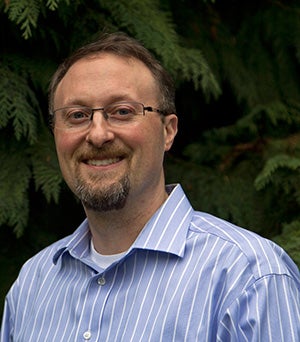Judging by the speed at which Rocco Luiere arrived at A&AA last July, he’s decisive. The new associate dean for finance and his family packed up their home in Las Vegas and were settled in Eugene just two weeks after he accepted the offer to work at Oregon.
Luiere was ready for a change. Since 2006 he had directed financial operations for gaming, lodging, and entertainment companies in Nevada’s biggest city. Prior to that, he managed finances in the telecom industry in New York.

Above: Rocco Luiere. Photo by Cody Rappaport.
“I enjoy very much what I do,” he says. “I love strategic planning, I like numbers, I like dealing with people, but as time went on, performing those functions in a for-profit environment offered me little more than a paycheck. After a while, I had to come to grip with the fact that my original career path didn’t ring true for me anymore.”
Higher education became Luiere’s top choice for achieving a balance between a career that could offer great challenge and one that could supply great meaning. “Higher ed institutions are huge, complicated, entities that drive both societal advancement and equity. I really wanted to be part of that.” So he embarked on a new job search, soon spotting the vacancy announcement at Oregon.
Now nearing his six-month mark at A&AA, Luiere says “I’m the happiest I’ve been in a job in I can’t tell you for how long.”
Luiere manages A&AA’s business affairs, which he defines as “people, processes, and resources.” Given the breadth of each of those three areas, his day-to-day duties can vary widely. “If you walk in here one day I’ll tell you my job has a lot to do with budgeting. If you walk in a different day I’ll tell you it has a lot to do with process engineering, and another day it’ll have to do with implementing the collective bargaining agreement.”
Asked how his experience in gaming and telecom translates to higher education, Luiere notes that all three are “asset-intensive industries. There is a lot of money [in all three industries] that has to go into bricks and mortar and computer technology in order to make them function, which means there’s this massive fixed cost sitting underneath the whole thing. That has huge implications on how you make long-term decisions. The way you have to approach the decision-making process is very similar across those industries.”
The other similar thread is economic recessions. “I was working in the telecom and gaming industries when they went through their big crashes in 2000 and 2008, so the exit of public funding for higher education and the crunch that that does on your resources is very similar to what I’ve been doing for the past fourteen years.”
Luiere is accustomed to working with big numbers. A staggering amount of money flows through Las Vegas; in his last position, Luiere oversaw planning and budgeting for a “smaller” company with 3,500 employees, sixty departments, and more than $500 million in revenues. During his full tenure in the industry, he was involved in raising and managing in excess of $6 billion of debt. By contrast, it costs about $23 million a year to run A&AA. However, Luiere insists the difference in magnitudes does not matter. “The fundamental principles of planning, decision making, and controls don’t change based on how many zeroes you round off on your financials.”
The $23 million operating budget has been “very stable” for the past three years, he says. “We’ve kept our costs in line. Over the past five to six years we’ve had a tremendous amount of growth as both PPPM and the Product Design Program have taken off. If you look back to 2008, our budget has grown 45 percent since then. It’s pretty substantial. Frances has been quite busy,” he says of A&AA Dean Frances Bronet.
The majority of the A&AA budget comes from tuition, which means as the student population fluctuates, so do revenues. When the Great Recession slammed the building industry, A&AA’s architecture and interior architecture programs saw declining enrollment. As the Product Design Program and PPPM department gained prominence, enrollment surged.
“It’s a very volatile cash flow stream that way,” Luiere says of the tuition-based funding model. “We are very dependent on a single source of income, which highlights how important further funding is; robust fundraising provides a stable basis for us from a long-term perspective.”
With more than 90 percent of the budget “payroll-headcount related,” using staff and faculty members efficiently is critical, he notes. That’s where process engineering comes in, to “take a look at how efficiently we can make it easier to function around here. A very simple example is what does it take to bring in a new faculty member—what’s the actual process you go through. We look at how we can make the process quicker and easier,” he says.
“We’re all support staff of the faculty,” he continues, “who are trying to get their research done, trying to bring the next generation of students up, and we need to provide support so they can spend as much of their time as possible doing the things they do best. I look at it as getting as much done as possible in the background, minimizing the touch points where the faculty have to get involved. So if they’re going to do a search committee, you want them focused on bringing in the right person; you don’t want them wasting time navigating through which administrative forms need to be completed before the candidate arrives.”
Luiere has a bachelor’s degree in business management and marketing from Cornell University and an MBA in corporate finance, accounting, and operations management from the University of Rochester.
He moved to Eugene with his wife, Stephanie, sons Cameron, 12, and Ian, 10, and 85-pound lapdog Pester.
